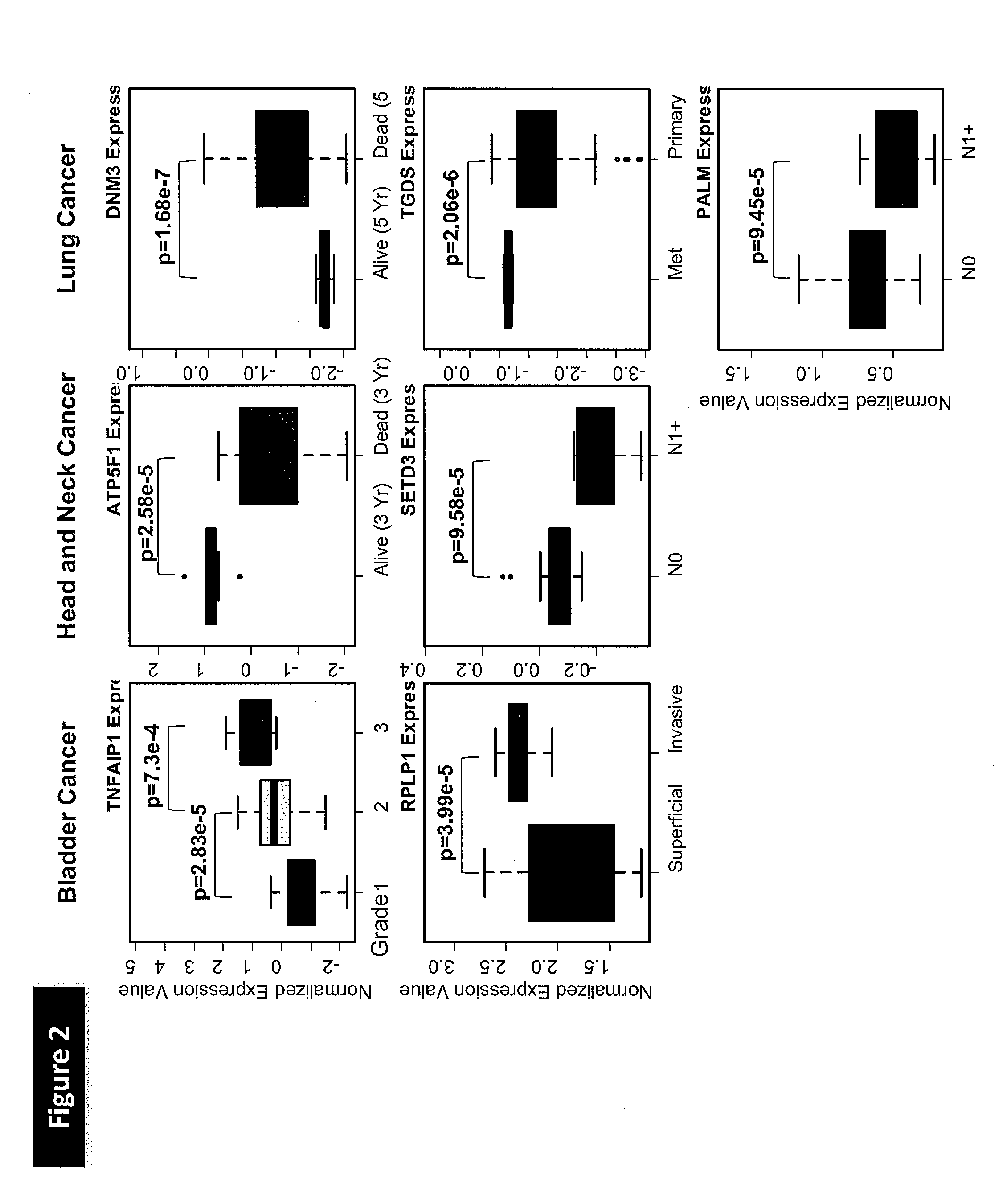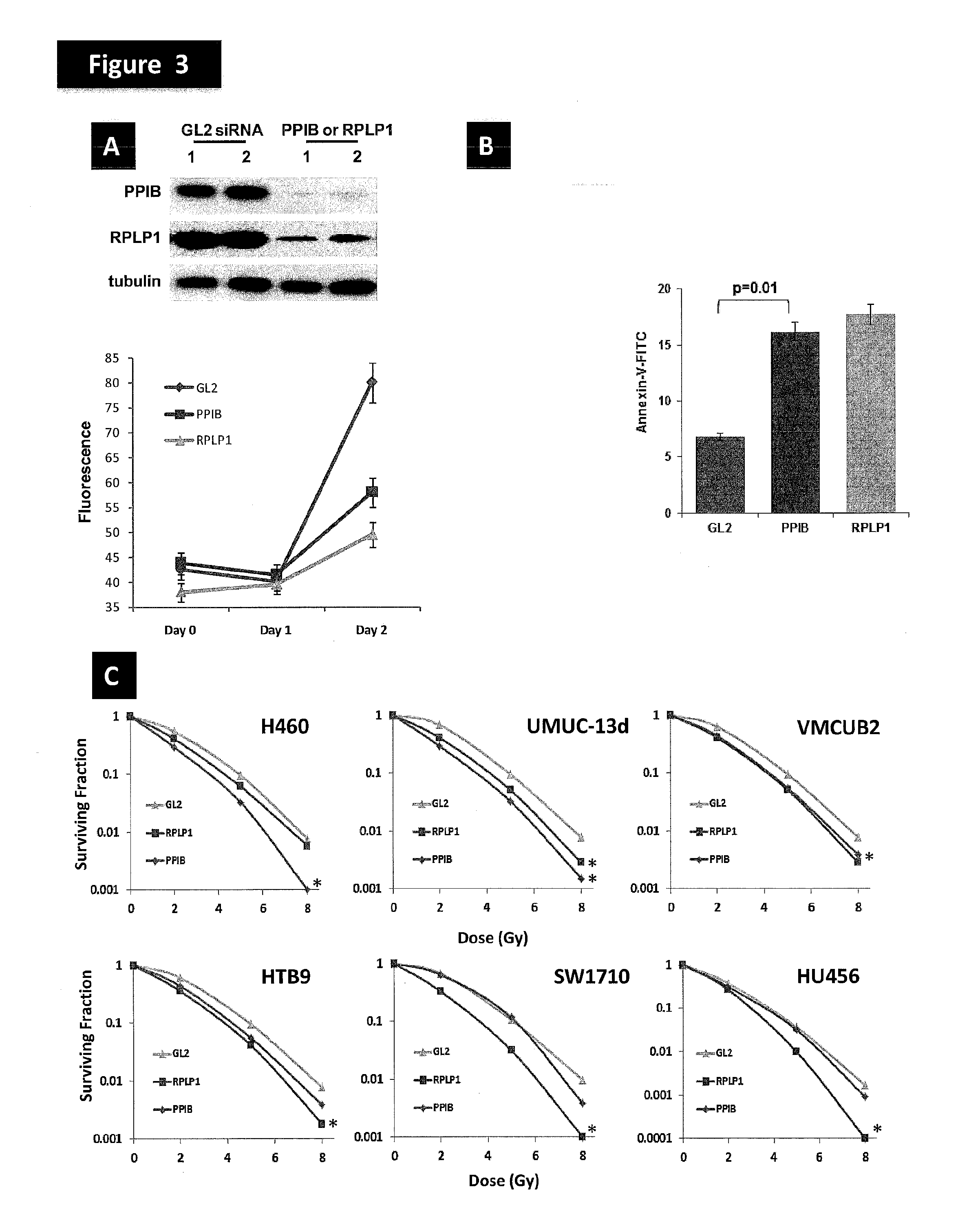Methods for prediction of clinical response to radiation therapy in cancer patients
a clinical response and radiation therapy technology, applied in the field of biomarkers, methods and assay kits, can solve the problems of not being highly predictive of the radiation sensitivity of patient tumors before treatment, and none of the genes identified are both biomarkers and potential targets for radio-sensitization
- Summary
- Abstract
- Description
- Claims
- Application Information
AI Technical Summary
Benefits of technology
Problems solved by technology
Method used
Image
Examples
example 1
This Example Illustrates the Development and Evaluation of the Radiation Response Prediction Gene Expression Model (GEM)
[0154]A schematic of model generation and validation process is depicted in FIG. 6 and is described in detail below.
[0155]Briefly, radiosensitivity data for both the bladder cancer (BLA-40, Table 1A) and primary Human Skin Fibroblasts (HSF) developed from skin biopsies collected from areas outside of the radiation field in patients undergoing radiotherapy (Brock, Table 1A), in the form of SF2 are shown in Tables 2A and 2B, respectively. Of the 8470 Affymetrix HG-U133A probe sets that had matching Illumina probes, the inventors found that 7515 probe sets survived the COXEN coexpression step between bladder cell lines and human tumors. The 300 probe sets most differentially expressed between the 17 most radiosensitive (SF2 range 0.19-0.51, avg. 0.39) and 10 most radioresistant (SF2 range 0.72-0.98, avg. 0.86) cell lines were chosen as candidate biomarkers for inclusi...
example 2
Illustrates the Accuracy and Specificity of the Radiation Response Prediction GEM in Patient Datasets
[0169]Utility of the 41 gene GEM in stratifying clinical outcome of patients treated with radiotherapy.
[0170]The inventors used the 41 gene GEM to predict the clinical response of patients with either lung cancer or HNSCC enrolled in two independent clinical studies. The Rickman HNSCC patient dataset (Tables 1A and 1B) comprised 81 patients, of which 73 were treated using radiotherapy alone, whereas 8 patients were treated with an unspecified chemotherapeutic regimen in addition to radiotherapy. Since chemotherapy may have a significant influence on patient response, and because the subset of patients treated with radiotherapy alone was sufficiently large, the inventors restricted the prediction assessment analysis to these 73 patients. Each patient was first assigned a GEM score indicating the predicted relative probability of response to radiation. To assess prediction performance ...
example 3
This Example Illustrates the Characteristics and Network Analysis of the 41 Genes in the GEM
[0177]To explore the functional properties of the genes in the radiotherapy response prediction GEM, the inventors found the gene information corresponding to the probe sets from the NetAffx website. The inventors queried the PANTHER Classification System database at pantherdb.org for gene ontology information corresponding to the genes in the model. No molecular function classification (FIG. 6A) was found for 15 of the 41 genes, while no biological process classification (FIG. 6B) was found for 16 of the 41 genes in the model. No GO terms were significantly over-represented among the genes for which such terms are available (hypergeometric test). However, biological process terms that are represented multiple times included immunity and defense (5 genes), transport (4 genes), cell proliferation and differentiation (3 genes), induction of apoptosis (3 genes). Gene expression and protein synth...
PUM
| Property | Measurement | Unit |
|---|---|---|
| temperature | aaaaa | aaaaa |
| temperature | aaaaa | aaaaa |
| ionic strength | aaaaa | aaaaa |
Abstract
Description
Claims
Application Information
 Login to View More
Login to View More - R&D
- Intellectual Property
- Life Sciences
- Materials
- Tech Scout
- Unparalleled Data Quality
- Higher Quality Content
- 60% Fewer Hallucinations
Browse by: Latest US Patents, China's latest patents, Technical Efficacy Thesaurus, Application Domain, Technology Topic, Popular Technical Reports.
© 2025 PatSnap. All rights reserved.Legal|Privacy policy|Modern Slavery Act Transparency Statement|Sitemap|About US| Contact US: help@patsnap.com



